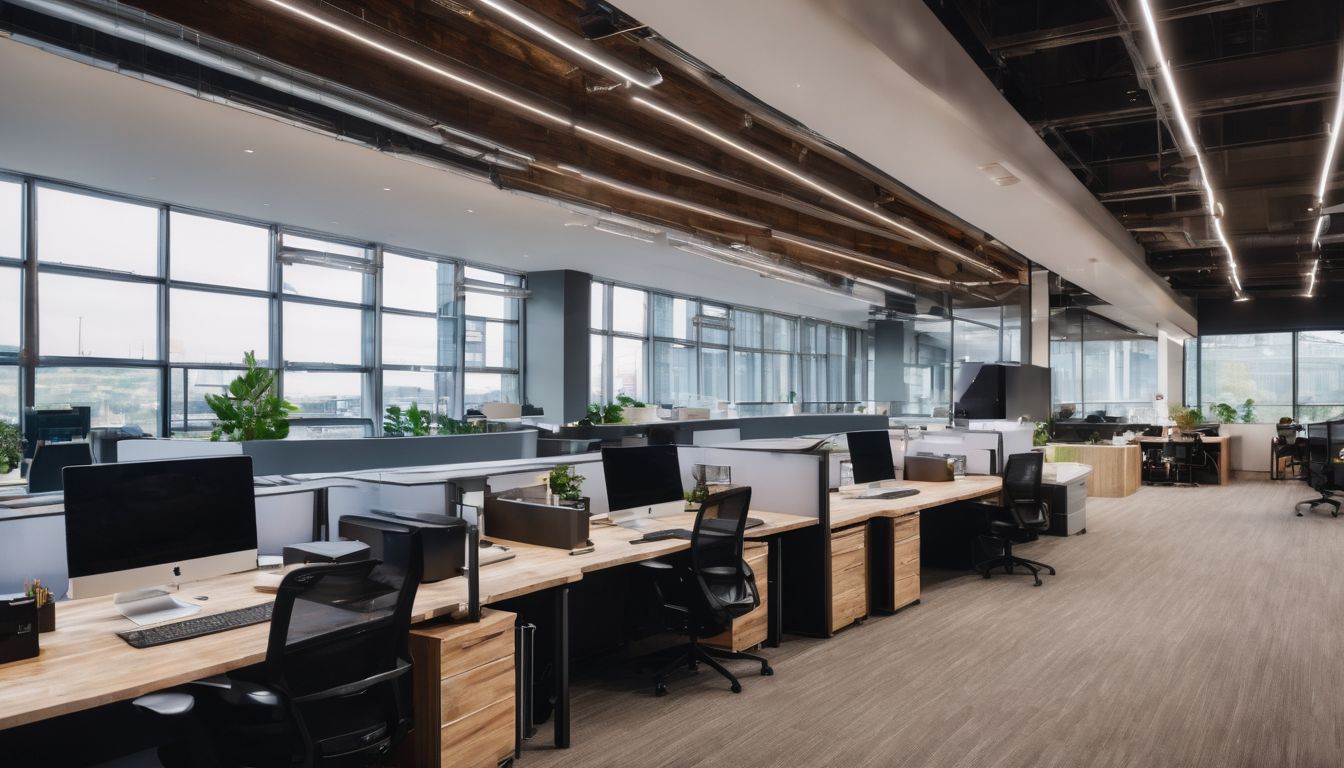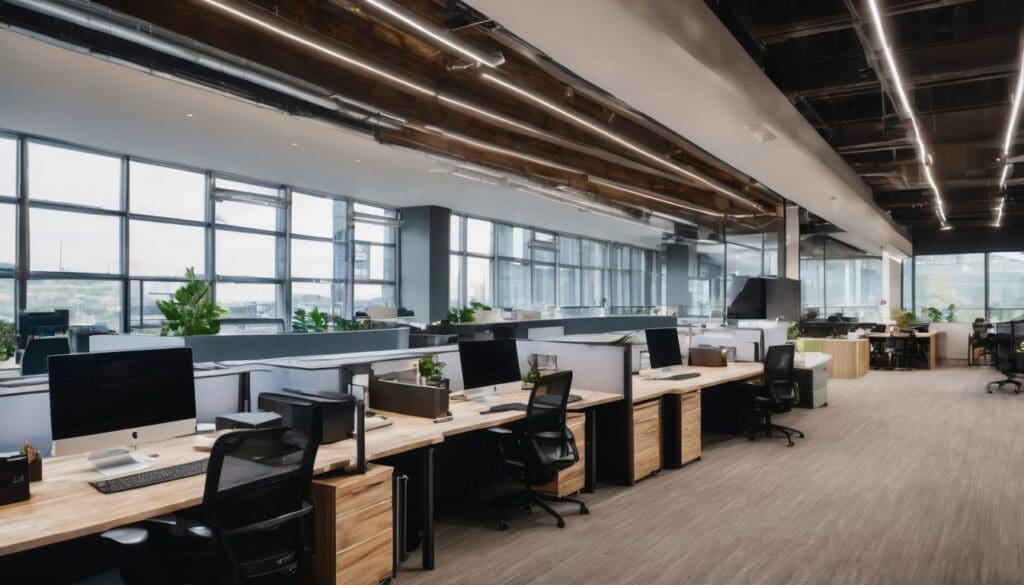 Lighting eats up a big chunk of energy in our homes and workplaces. Surprisingly, about 5% of global CO2 emissions come from simply lighting our spaces. This article will show you how swapping to eco-friendly choices can cut your bills and carbon footprint.
Lighting eats up a big chunk of energy in our homes and workplaces. Surprisingly, about 5% of global CO2 emissions come from simply lighting our spaces. This article will show you how swapping to eco-friendly choices can cut your bills and carbon footprint.
Let’s shine a light on greener options!
Key Takeaways
- Swapping old lighting for LED bulbs can dramatically lower electricity bills and reduce greenhouse gas emissions, making a big impact on energy conservation in buildings.
- Utilising natural light through skylights and large windows not only cuts down on electric usage but also boosts the mood and productivity of people inside by connecting them to the outside world.
- Solar-powered lighting systems are now more efficient and less costly than before, offering a reliable alternative that decreases reliance on fossil fuels and supports off-grid living.
- Innovative daylight harvesting technology works with LED lights to tailor artificial brightness based on available sunlight, saving even more energy while maintaining consistent indoor lighting levels.
- Choosing vendors who prioritise eco – friendly practices ensures that sustainable lighting products contribute towards reduced environmental impact right from production through to end use.
The Benefits of Sustainable Lighting for Buildings
Sustainable lighting in buildings offers enhanced energy efficiency and reduced electricity usage, leading to cost savings. It also contributes to improved well-being and productivity for occupants while allowing for design flexibility and aesthetic appeal.
Enhanced energy efficiency
Eco-friendly lighting solutions dramatically slash electricity usage in buildings. Swapping out old, energy-intensive HID lamps for energy-efficient LED ones cuts down on power consumption and reduces greenhouse gas emissions.
This switch not only benefits the environment but also saves a substantial amount on electricity bills.
Opting for LEDs and other low-impact lighting options plays a key role in green building design. Technological advancements have made these eco-conscious lighting choices more accessible and effective than ever before.
They last longer than traditional bulbs, which means less waste and fewer replacements are needed over time—another win for eco-friendly office lighting efforts.
Improved well-being and productivity
Transitioning from enhanced energy efficiency to improved well-being and productivity, eco-friendly lighting solutions contribute to creating healthier and more productive indoor environments.
Energy-efficient LED lighting reduces eye strain and fatigue, promoting better focus and productivity in workspaces. Additionally, natural daylight exposure has been linked to improved mood, reduced stress levels, and better sleep patterns among occupants.
By incorporating sustainable lighting options such as task lighting and dimmers, buildings can create comfortable and adaptable spaces that enhance the overall well-being of individuals while supporting environmental conservation efforts.
Design flexibility and aesthetics
Improved well-being and productivity in buildings also go hand in hand with the design flexibility and aesthetics offered by eco-friendly lighting solutions. Incorporating sustainable lighting not only enhances energy efficiency but also allows for a diverse range of design options, ensuring that environmental consciousness does not compromise on style or creativity within building spaces.
Green tips for lighting and renewable energy sources are paving the way for innovative, aesthetically pleasing illumination choices that align with environmentally conscious values, making it easier than ever to embrace eco-friendly office lighting without sacrificing visual appeal or functionality.
Ecoconscious lighting such as LED bulbs and dimmers provide energy-efficient LED solutions while enhancing the aesthetic ambiance of green building settings. Technological advancements in lighting have enabled low-impact and environment-friendly illumination that meets both design requirements and sustainability objectives, providing a plethora of options for creating visually stunning yet eco-friendly office environments.
Types of Sustainable Lighting Solutions
Natural lighting, solar-powered lighting, LED lighting, and bioluminescent lighting are all eco-friendly options for illuminating buildings. Each type offers unique benefits in terms of energy efficiency and environmental impact.
Natural lighting
Natural lighting, with its reliance on sunlight to illuminate indoor spaces, is an essential component of sustainable building design. It not only reduces the need for artificial lighting but also contributes to energy efficiency in commercial and residential buildings.
Incorporating elements such as skylights, large windows, and light wells maximises the use of natural daylight while reducing dependence on electricity. By harnessing this eco-friendly illumination source, businesses and homeowners can significantly lower their energy consumption while creating a healthier and more inviting environment for occupants.
Moreover, natural lighting enhances well-being by providing a connection to the outdoors and supporting circadian rhythms. Utilising innovative strategies like daylight harvesting systems further amplifies the benefits of natural lighting by optimising its usage throughout different times of day and seasons.
Solar-powered lighting
Solar-powered lighting offers an eco-friendly and sustainable solution for buildings, harnessing the power of the sun to illuminate indoor and outdoor spaces. By using solar panels to capture sunlight and convert it into electricity, this type of lighting reduces reliance on traditional energy sources, ultimately lowering utility bills and decreasing environmental impact.
Solar-powered lighting also provides independence from the grid, making it an ideal choice for remote or off-grid locations where connecting to a power supply may be challenging.
Utilising renewable energy sources such as solar power aligns with the principles of environmentally conscious individuals who prioritise conservation. With advancements in technology, solar-powered lighting systems have become more efficient and affordable, offering a reliable and attractive option for environmentally friendly illumination in both residential and commercial buildings.
LED lighting
LED lighting is a popular and energy-efficient option for eco-friendly illumination in buildings. It offers long-lasting performance, reducing the need for frequent replacements and lowering energy consumption.
With dimmers for lighting, LED fixtures allow flexible control of light levels, contributing to an environmentally conscious approach while creating a comfortable workspace. By choosing sustainable vendors offering energy-efficient LED solutions, buildings can significantly decrease their environmental impact and support conservation efforts.
Energy-efficient LED lighting not only delivers cost savings but also aligns with green building practices. Incorporating low-impact lighting choices like LED into building designs plays a crucial role in creating environmentally friendly spaces that promote sustainability and reduce overall energy consumption.
Bioluminescent lighting
Bioluminescent lighting harnesses the natural light emitted by living organisms, offering a unique and sustainable way to illuminate buildings. This eco-friendly illumination is achieved through the use of bioluminescent bacteria or algae, providing a soft glow that requires minimal energy consumption.
By integrating bioluminescent lighting into building design, it’s possible to reduce reliance on traditional electric lighting and embrace a greener approach to illuminating indoor spaces.
Looking ahead in sustainable building design, exploring the potential of bioluminescent lighting could open up new avenues for creating environmentally-friendly and visually appealing spaces.
As technology advances, incorporating this natural form of lighting into architectural designs holds promise for reducing energy consumption while promoting an eco-conscious approach.
Implementing Sustainable Lighting in Buildings
Implementing sustainable lighting in buildings requires the use of daylight harvesting systems and passive heating techniques. It also involves choosing sustainable vendors who provide eco-friendly lighting products.
Daylight harvesting systems
Daylight harvesting systems utilise natural light to illuminate interior spaces, reducing the need for artificial lighting and saving energy. Using sensors or automated controls, these systems adjust the artificial light levels in response to the available daylight, ensuring a consistent illumination level while maximising energy savings.
By integrating daylight harvesting systems with LED lighting solutions, buildings can significantly reduce their energy consumption while providing occupants with a well-lit and eco-friendly environment.
Leveraging daylight harvesting systems not only lowers utility bills but also supports sustainable building practices, aligning with environmentally conscious initiatives. The combination of natural light and energy-efficient LED lighting contributes to creating healthier indoor environments and reducing carbon footprints associated with traditional lighting solutions.
Passive heating
Passive heating utilises building design and materials to maximise natural heat gain from the sun. This approach reduces the need for mechanical heating systems, promoting energy efficiency and cost savings.
By strategically positioning windows, incorporating thermal mass materials, and utilising solar shading devices, buildings can optimise solar exposure in winter months, keeping interiors warm without relying heavily on artificial heating sources.
Embracing passive heating not only lowers energy consumption but also aligns with eco-friendly initiatives by reducing a building’s carbon footprint. Integrating this approach into sustainable lighting solutions contributes to creating environmentally responsible buildings that prioritise energy-efficient practices.
Choosing sustainable vendors
When selecting vendors for sustainable lighting solutions, consider their commitment to eco-friendly practices. Look for suppliers who offer energy-efficient LED lighting and other environmentally friendly illumination options.
Ensure that the chosen vendors provide green building lighting products that align with your conservation goals.
Evaluate the efficiency of the vendor’s products, focusing on renewable energy lighting and low-impact solutions. Seek out companies that prioritise energy-saving lighting solutions and environmentally conscious designs.
The Future of Sustainable Lighting in Building Design
The future of sustainable lighting in building design is evolving rapidly. Advancements in technology and design are paving the way for even more energy-efficient and environmentally friendly lighting solutions.
Innovations such as smart sensors, advanced control systems, and integration with renewable energy sources are becoming increasingly prevalent, allowing buildings to optimise their lighting usage based on natural light availability and occupancy, thus reducing energy consumption significantly.
Additionally, ongoing research into materials and production processes continues to bring about more sustainable lighting products that minimise environmental impact throughout their lifecycle.
Furthermore, with the increasing focus on wellness in building design, future sustainable lighting is likely to integrate circadian rhythm principles to enhance occupant comfort and productivity.
This approach aims at aligning artificial lighting with natural daylight patterns to support the body’s internal clock. Overall, the trajectory of sustainable lighting in building design is towards a harmonious blend of energy efficiency, environmental consciousness, human-centric designs, and technological innovation.
Conclusion
In conclusion, eco-friendly lighting solutions for buildings offer numerous benefits. They enhance energy efficiency, improve overall well-being and productivity, and provide design flexibility and aesthetics.
By incorporating sustainable lighting options such as natural lighting, solar-powered lighting, LED lighting, and bioluminescent lighting, buildings can significantly reduce their environmental impact.
Implementing these solutions through daylight harvesting systems, passive heating techniques, and choosing sustainable vendors will pave the way for a greener future in building design.
FAQs
1. What are eco-friendly lighting solutions for buildings?
Eco-friendly lighting solutions include energy-efficient LED lights and other low-impact, green lighting products designed to reduce energy consumption in buildings.
2. How can an office become more eco-friendly with its lighting?
By installing energy-efficient LEDs and choosing eco-conscious office lighting, offices can save energy and contribute to a greener environment.
3. Can eco-friendly illumination make a big difference in energy savings?
Yes, eco-friendly illumination options like energysaving LED lights significantly cut down electricity usage, leading to both environmental benefits and cost savings.
4. Why should I choose ecofriendly lighting products over traditional ones?
Ecofriendly lighting products have a lower environmental impact, offering sustainability advantages such as reduced carbon emissions while providing bright, effective light.
5. Are there specific types of green lighting suitable for all buildings?
Energyefficient LED bulbs are versatile and work well across different building types; their long life span makes them suitable for widespread use in various settings.


